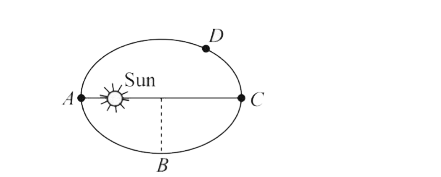The magnetic field due to the earth has a horizontal component of 26μT at a place where the dip is 60∘. Find the vertical component and the magnitude of the field.
To solve the problem, we need to find the vertical component of the magnetic field and the magnitude of the magnetic field given the horizontal component and the angle of dip.
Step 1: Understand the relationship between components of the magnetic field
The magnetic field of the Earth can be resolved into two components: the horizontal component (Bh) and the vertical component (Bv). The angle of dip (δ) relates these components through the following equations:
- Horizontal component: Bh=Bcos(δ)
- Vertical component: Bv=Bsin(δ)
Step 2: Given values
From the problem, we have:
- Horizontal component, Bh=26μT=26×10−6T
- Angle of dip, δ=60∘
Step 3: Calculate the magnitude of the magnetic field (B)
Using the equation for the horizontal component:
Bh=Bcos(δ)
Substituting the known values:
26×10−6=Bcos(60∘)
Since cos(60∘)=12, we can rewrite the equation as:
26×10−6=B⋅12
To find B, multiply both sides by 2:
B=52×10−6T=52μT
Step 4: Calculate the vertical component (Bv)
Now, we can find the vertical component using:
Bv=Bsin(δ)
Substituting the values we have:
Bv=52×10−6⋅sin(60∘)
Since sin(60∘)=√32, we can rewrite it as:
Bv=52×10−6⋅√32
Calculating this gives:
Bv=52×10−6⋅0.866=44.98μT≈45μT
Summary of Results
- Vertical component Bv≈45μT
- Magnitude of the magnetic field B≈52μT
The magnetic field of the Earth can be resolved into two components: the horizontal component (Bh) and the vertical component (Bv). The angle of dip (δ) relates these components through the following equations:
- Horizontal component: Bh=Bcos(δ)
- Vertical component: Bv=Bsin(δ)
From the problem, we have:
- Horizontal component, Bh=26μT=26×10−6T
- Angle of dip, δ=60∘
Using the equation for the horizontal component:
Bh=Bcos(δ)
Substituting the known values:
26×10−6=Bcos(60∘)
Since cos(60∘)=12, we can rewrite the equation as:
26×10−6=B⋅12
To find B, multiply both sides by 2:
B=52×10−6T=52μT
Now, we can find the vertical component using:
Bv=Bsin(δ)
Substituting the values we have:
Bv=52×10−6⋅sin(60∘)
Since sin(60∘)=√32, we can rewrite it as:
Bv=52×10−6⋅√32
Calculating this gives:
Bv=52×10−6⋅0.866=44.98μT≈45μT
- Vertical component Bv≈45μT
- Magnitude of the magnetic field B≈52μT
Topper's Solved these Questions
- PERMANENT MAGNETSBOOK - HC VERMA ENGLISHCHAPTER - PERMANENT MAGNETSEXERCISE - Short Answer
11 Videos
- PERMANENT MAGNETSBOOK - HC VERMA ENGLISHCHAPTER - PERMANENT MAGNETSEXERCISE - Objective II
1 Videos
- OPTICAL INSTRUMENTSBOOK - HC VERMA ENGLISHCHAPTER - OPTICAL INSTRUMENTSEXERCISE - Question for short Answer
12 Videos
- PHOTO ELECTRIC EFFECT AND WAVE PARTICLE DUALITYBOOK - HC VERMA ENGLISHCHAPTER - PHOTO ELECTRIC EFFECT AND WAVE PARTICLE DUALITYEXERCISE - question for short answer
13 Videos
Similar Questions
Earth's magnetic field always has a horizontal component except at
View SolutionIn the magnetic meridian of a certain place, the horizontal component of earth's magnetic fied is 0.26G and the dip angle is 60∘. Find
a. Vertical component of earth's magnetic field
b. the net magnetic field at this place
View SolutionThe horizontal component of earth.s magnetic field On at a place is 1√3 times the vertical component. Determine the angle of dip at that place.
View SolutionThe horizontal component of the earth's magnetic field is 3.6×10−5T where the dip is 60∘. Find the magnitude of the earth's magnetic field.
View SolutionThe earth's magnetic field always has a vertical component except at the
View SolutionAt a certain place , horizontal component of earth's field is √3 times the vertical component of earth's field . The angle of dip at this place is
View SolutionCalculate earth's magnetic field at a place where angle of dip δ is 60∘ and horizontal component of earth's magnetic field is 0.3 G
View SolutionThe value of horizontal component of earth's magnetic field at a place is −.35×10−4T. If the angle of dip is 60∘, the value of vertical component of earth's magnetic field is about:
View SolutionThe earth's magnetic field at a certain place has a horizontal component 0.3 Gauss and the total strength 0.5 Gauss. The angle of dip is
View SolutionA planet revolves around the sun in an elliptical orbit. The linear speed of the planet will be maximum at:

View Solution
